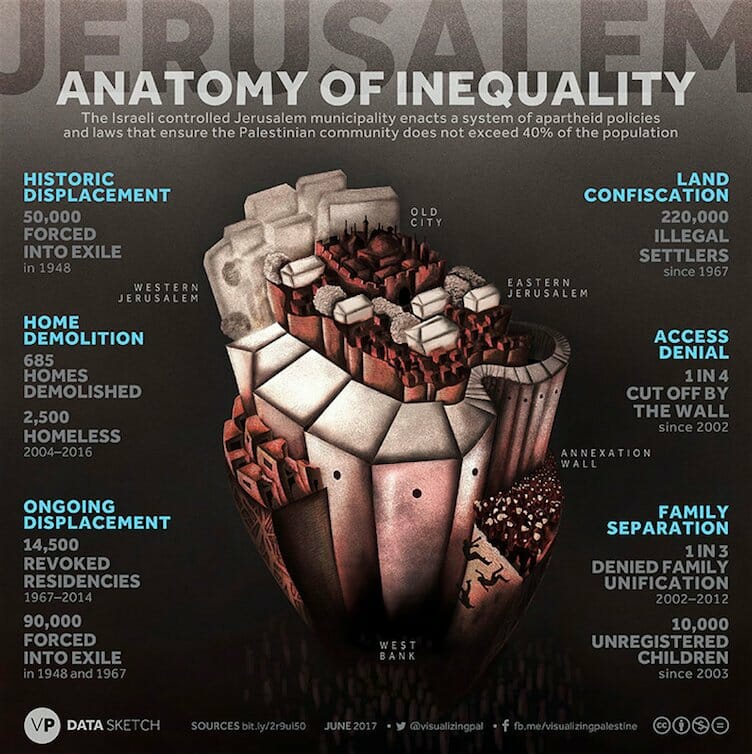Colonization and Gentrification

The displacement of people is an enduring injustice across the globe. Whether due to violent conflict, climate change disasters, development projects benefiting corporations over humans, or colonization, people are being forced from their homes, communities, and lands.
Displacement in both Palestine and the US stem from the colonial mindset of those in power , which necessitates “civilizing” a land of “savages.” According to this model, local communities are replaced rather than lived alongside as the displacers recreate a land in their own image.
Moderated by Sandra Tamari of the Adalah Justice Project, the Resisting Displacement from Jerusalem to St. Louis: Stories of Colonization and Gentrification webinar helps draw connections across borders while acknowledging that each context is different, and shares lessons about resisting the oppressive systems forcing people from their homes and lands. Ingrid Jaradat highlights Israel’s colonization of Jerusalem and attempts to Judaize the city by displacing its native Palestinian population, and Sheila Rendon shares her personal story of being impacted by gentrification in St. Louis, Missouri through eminent domain.
Eminent Domain
Eminent domain is a tactic commonly used to advance gentrification. It refers to the power of a state to claim private property for public use. This often happens through the state using symptoms of its own neglect, such as crumbling infrastructure, as a pretense to displace communities. States will use the cover of public use to seize properties to sell to private developers for large profits that are not then used to invest in community needs, and/or to set up public redevelopment campaigns such as parks that do not necessarily address the direct needs of communities. The new housing that developers build tends to not have enough low-cost options. Or the redevelopment projects drive up rents and property taxes and lower income communities are forced to move away. Thus the people’s whose properties the state seized for public use can no longer afford to live in their own communities. This very much advances the goal of gentrification, which is to replace lower income communities, often Black and brown, with more affluent residents. Entire communities are eventually pushed out of their neighborhoods, which often occurs hand-in-hand with increased police violence as government policies ostensibly aimed at making cities safer for their new, more affluent residents translate into more neighborhood policing.
Jerusalem
In Jerusalem, Israel is attempting to create an Jewish demographic majority through the forced displacement, dispossession, and continuing impoverishment of thousands of Palestinians in the city. One of the main tools of colonization in occupied East Jerusalem are Israeli land and planning laws that legalize the confiscation of large amounts of Palestinian land for public needs, and the denial of permits to Palestinians to build or repair houses in an effort to push them out of the city. Almost 200,000 Israeli settlers live on stolen Palestinian land in East Jerusalem, while the apartheid wall separates about 140,000 Palestinians in Jerusalem neighborhoods like Kufr Aqab, Qalandiya, and Abu Dis, from the rest of the city. Palestinian Jerusalemites are also denied access to basic infrastructure: only 59 percent of the 324,000 Palestinians in Jerusalem are connected to the city’s official water grid.
For Palestinian Jerusalemites, Israel’s Kafkaesque system of residency status is a powerful tool of dispossession by the state. Since 1967, Israel has revoked the residency status of roughly 15,000 Palestinians in Jerusalem, and in March 2018, a law was passed that grants the Israeli interior minister full power to revoke the Jerusalem residencies of Palestinians over allegations of “breaching allegiance” or “loyalty” to the Israeli state. Israel’s actions in Jerusalem are a microcosm of its colonial Zionist project across Palestine.
Watch and Learn
Watch Resisting Displacement from Jerusalem to St. Louis: Stories of Colonization and Gentrification to learn more.
For the Visual Learner

